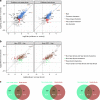The Hsp90 isoforms from S. cerevisiae differ in structure, function and client range
- PMID: 31399574
- PMCID: PMC6689086
- DOI: 10.1038/s41467-019-11518-w
The Hsp90 isoforms from S. cerevisiae differ in structure, function and client range
Abstract
The molecular chaperone Hsp90 is an important regulator of proteostasis. It has remained unclear why S. cerevisiae possesses two Hsp90 isoforms, the constitutively expressed Hsc82 and the stress-inducible Hsp82. Here, we report distinct differences despite a sequence identity of 97%. Consistent with its function under stress conditions, Hsp82 is more stable and refolds more efficiently than Hsc82. The two isoforms also differ in their ATPases and conformational cycles. Hsc82 is more processive and populates closed states to a greater extent. Variations in the N-terminal ATP-binding domain modulate its dynamics and conformational cycle. Despite these differences, the client interactomes are largely identical, but isoform-specific interactors exist both under physiological and heat shock conditions. Taken together, changes mainly in the N-domain create a stress-specific, more resilient protein with a shifted activity profile. Thus, the precise tuning of the Hsp90 isoforms preserves the basic mechanism but adapts it to specific needs.
Conflict of interest statement
The authors declare no competing interests.
Figures






Similar articles
-
The conserved NxNNWHW motif in Aha-type co-chaperones modulates the kinetics of Hsp90 ATPase stimulation.Nat Commun. 2019 Mar 20;10(1):1273. doi: 10.1038/s41467-019-09299-3. Nat Commun. 2019. PMID: 30894538 Free PMC article.
-
Allosteric regulation of the Hsp90 dynamics and stability by client recruiter cochaperones: protein structure network modeling.PLoS One. 2014 Jan 20;9(1):e86547. doi: 10.1371/journal.pone.0086547. eCollection 2014. PLoS One. 2014. PMID: 24466147 Free PMC article.
-
Crystal structure of an Hsp90-nucleotide-p23/Sba1 closed chaperone complex.Nature. 2006 Apr 20;440(7087):1013-7. doi: 10.1038/nature04716. Nature. 2006. PMID: 16625188 Free PMC article.
-
Hsp90 and co-chaperones twist the functions of diverse client proteins.Biopolymers. 2010 Mar;93(3):211-7. doi: 10.1002/bip.21292. Biopolymers. 2010. PMID: 19697319 Free PMC article. Review.
-
The HSP90 chaperone machinery.Nat Rev Mol Cell Biol. 2017 Jun;18(6):345-360. doi: 10.1038/nrm.2017.20. Epub 2017 Apr 21. Nat Rev Mol Cell Biol. 2017. PMID: 28429788 Review.
Cited by
-
Enabling malic acid production from corn-stover hydrolysate in Lipomyces starkeyi via metabolic engineering and bioprocess optimization.Microb Cell Fact. 2025 May 21;24(1):117. doi: 10.1186/s12934-025-02705-0. Microb Cell Fact. 2025. PMID: 40394595 Free PMC article.
-
The Onset of Molecule-Spanning Dynamics in Heat Shock Protein Hsp90.Adv Sci (Weinh). 2023 Dec;10(36):e2304262. doi: 10.1002/advs.202304262. Epub 2023 Nov 20. Adv Sci (Weinh). 2023. PMID: 37984887 Free PMC article.
-
Acetylation of the yeast Hsp40 chaperone protein Ydj1 fine-tunes proteostasis and translational fidelity.PLoS Genet. 2024 Dec 9;20(12):e1011338. doi: 10.1371/journal.pgen.1011338. eCollection 2024 Dec. PLoS Genet. 2024. PMID: 39652584 Free PMC article.
-
Quantitative proteomic analysis reveals unique Hsp90 cycle-dependent client interactions.Genetics. 2024 Jun 5;227(2):iyae057. doi: 10.1093/genetics/iyae057. Genetics. 2024. PMID: 38606935 Free PMC article.
-
The known unknowns of the Hsp90 chaperone.Elife. 2024 Dec 31;13:e102666. doi: 10.7554/eLife.102666. Elife. 2024. PMID: 39737863 Free PMC article. Review.
References
Publication types
MeSH terms
Substances
LinkOut - more resources
Full Text Sources
Molecular Biology Databases

